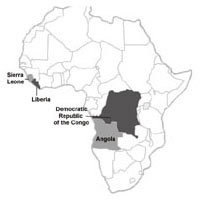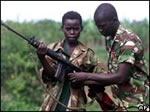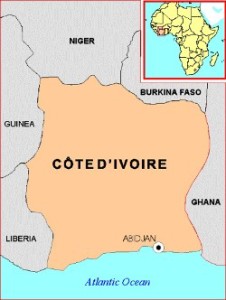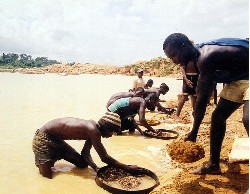 In the mid 1990s, 10 to 15 percent of the world’s supply of diamonds came from African war zones such as Angola, Congo and Sierra Leone. In these areas, diamond mines owned and operated by local warlords funded revolutionary efforts through the sale of diamonds on the world market. Diamonds from these countries carry the label “conflict diamonds” or “blood diamonds” because of the atrocities inflicted against the citizens of these regions.
In the mid 1990s, 10 to 15 percent of the world’s supply of diamonds came from African war zones such as Angola, Congo and Sierra Leone. In these areas, diamond mines owned and operated by local warlords funded revolutionary efforts through the sale of diamonds on the world market. Diamonds from these countries carry the label “conflict diamonds” or “blood diamonds” because of the atrocities inflicted against the citizens of these regions.
Smuggling these blood diamonds from the illegal mines to the legitimate marketplace is possible because of the nature of diamonds themselves: they are valuable and easily concealed. It is easy to transport and resell this compact form of currency. For example, Angola’s National Union for the Total Independence of Angola (UNITA) rebels have raised close to $4 billion in the 1990s, and Sierra Leone’s Revolutionary United Front sold at least $630 million in diamonds to Liberia in exchange for support and weapons.
The suffering due to these wars is staggering with hundreds of thousands dead as a direct and indirect result of the war and millions of people displaced and their health, business and educational infrastructure devastated.
Funding Conflict
 Conflict diamonds were primarily associated with four countries: Sierra Leone, Angola, Liberia and the Democratic Republic of Congo. The wars in Angola and Sierra Leone have ended. These two conflicts alone generated over 4 million refugees and internally displaced persons, resulted in some 700,000 deaths and produced over 12,000 child soldiers.
Conflict diamonds were primarily associated with four countries: Sierra Leone, Angola, Liberia and the Democratic Republic of Congo. The wars in Angola and Sierra Leone have ended. These two conflicts alone generated over 4 million refugees and internally displaced persons, resulted in some 700,000 deaths and produced over 12,000 child soldiers.
Liberia’s long and horrific war has also ended, but the country still is under a diamond embargo instituted by the United Nations. The country is working to develop a diamond monitoring system based on Kimberly Process standards and hopes to get the United Nations Sanctions lifted.
Conflict diamonds continue to sustain instability in the Democratic Republic of Congo (DRC), often described as one of the worst humanitarian crises in the world.
 Currently, the only major source of conflict diamonds is in the rebel-held areas of northern Côte d’Ivoire. Millions of dollars of conflict diamonds from Côte d’Ivoire are being smuggled through Ghana on the way to the legitimate diamond marketplace.
Currently, the only major source of conflict diamonds is in the rebel-held areas of northern Côte d’Ivoire. Millions of dollars of conflict diamonds from Côte d’Ivoire are being smuggled through Ghana on the way to the legitimate diamond marketplace.
Overall, these civil wars have impeded development, provoked widespread hunger and food insecurity, and derailed education. Countries and regions affected by such conflict have seen entire generations growing up with few opportunities or prospects for a healthy life. People live in a constant state of fear as they see their livelihoods and futures destroyed. To make things worse, diamond revenues are still misused to fund corruption, instead of to address critical health and education needs.
Profiting from War
The conflicts in Angola, Sierra Leone, and the Democratic Republic of Congo fit a pattern of civil conflict often seen in countries rich in natural resources such as diamonds. These civil conflicts may appear to be political struggles, but they are all too frequently conflicts over control of commodities such as easily mined and exported diamonds. This reality of greed was sometimes obscured during the Cold War era, when rival superpowers would fund opposing groups in order to support their own political agendas.
Now it is easier to see that some groups and individuals profit from war. They have little incentive to seek peace as long as they continue to prosper from control of commodity exports such as diamonds. These combatants can be government forces, so-called rebel groups, or even mercenaries working for diamond prospectors. Commodities like diamonds, easily extracted in raw form, are often indistinguishable from those originating in a peaceful country. Countries with few primary exports are more prone to such a violent consolidation of control over income from the nation’s resources.
De Beers Response
De Beers initially suggested enacting tough regulations against the sale of conflict diamonds, recommending that smuggled gem dealers be ousted from industry organizations. This seemingly socially conscious stance only masked De Beers’ efforts to maintain control of its well-developed cartel. In addition, when diamonds are associated with the support of violent warfare in Africa, the image of the diamond industry as a whole is tarnished.
Negative publicity in recent years highlighted the social ramifications of smuggling these conflict diamonds and brought media and civil society attention to this issue. De Beers recognizes that by eliminating conflict diamonds, it stands to not only gain market share but also protect the reputation of its industry.
Restrictions and Barriers
Several attempts have been made to crack down on the illegal trade in diamonds. In 2000, the UN Security Council issued an 18-month embargo prohibiting the sale of rebel diamonds from both Angola and Sierra Leone. By restricting imports of rough diamonds from conflict areas, the embargo tightened controls on the illegal diamond trade funding civil wars.
 The Kimberley Process is an international negotiation which began in 2000 by South Africa and more than 20 other countries. The negotiation, which was formally launched in November 2002, aims to solve the problems by controlling rough diamond trade. As a measure to bar smuggled conflict diamonds, the nations agreed to establish minimum acceptable international standards for certification of rough diamonds. According to the proposal, participant countries have to ensure the following:
The Kimberley Process is an international negotiation which began in 2000 by South Africa and more than 20 other countries. The negotiation, which was formally launched in November 2002, aims to solve the problems by controlling rough diamond trade. As a measure to bar smuggled conflict diamonds, the nations agreed to establish minimum acceptable international standards for certification of rough diamonds. According to the proposal, participant countries have to ensure the following:
- Rough diamonds are imported and exported in tamper-resistant containers, accompanied by a Kimberley Process Certificate certifying the country of origin, identification of exporter and importer, carat weight/mass and value, etc.
- No shipment of rough diamonds imported from or exported to a non-participant.
- A system of internal controls established to eliminate the presence of conflict diamonds from shipments of rough diamonds imported into and exported from its territory.
- Appropriate laws or regulations amended or enacted to implement and enforce the certification scheme and to maintain dissuasive and proportional penalties for transgressions.
- Relevant official production, import and export data are collected and maintained.
United States Response
The Clean Diamond Trade Act was introduced in March 2002 to broaden the definition of conflict diamonds and combat their import into the United States. As a response to the attack on the World Trade Center, the bill broadens the definition of conflict diamonds to include diamonds traded by terrorists and those who use the diamond trade to fund human rights abuses against unarmed citizens. The bill specifies the following:
- The president has authority to impose sanctions on any country that does not assure that its rough diamonds come from a “clean stream” and to prohibit imports of polished diamonds and diamond jewelry if there is credible evidence they were produced with conflict diamonds.
- The president must report annually to Congress on the system’s effectiveness, on which countries are not implementing it and the effects of their actions on the illicit trade in diamonds.
- The president was encouraged to negotiate immediately, in conjunction with the Kimberley Process, an international agreement designed to eliminate the illicit trade in diamonds.
Most wholesale and retail diamond companies now declare that their internal procedures exclude conflict diamonds from their business. This, however, is not sufficient. The diamond industry as a whole, including diamond mining, cutting, exporting, and importing countries, must establish a system that will reduce the trade in conflict stones.
Such a “rough controls” regime will require a comprehensive, transparent way to establish the origin of a diamond. Regulations are also necessary for legitimate export and import centers, customs and excise regimens in importing countries, and international inspection of diamond packets.
 The US is the largest importer of diamonds in the world and therefore has a unique responsibility to ensure that choices made by American consumers do not contribute to conflict in Africa.
The US is the largest importer of diamonds in the world and therefore has a unique responsibility to ensure that choices made by American consumers do not contribute to conflict in Africa.
Americans currently buy 65 percent of the world’s diamonds, so it is essential for the success of the emerging international system that the US market excludes conflict diamonds. The US legislation and the Kimberley System aim to reduce the incentive to fight for control of diamond-producing areas and make armed groups more inclined to seek peace.
Clean Diamond legislation will also protect the majority of legitimate producers of diamonds. Public outcry around the conflict diamond issue is potentially damaging to the legitimate suppliers of diamonds from other countries in Africa. These countries rely on diamonds to fund, among other things, their health and education ministries. Only time will tell if these measures will improve the conflict diamond situation.
Diamond Development Initiative
 More than a million African diamond diggers and their families live and work in absolute poverty in countries struggling to recover from the ravages of war. The sources of conflict diamonds are in the vast alluvial diamond areas in Africa. Alluvial diamonds, unlike those mined in the deep kimberlite pipes of Botswana, Russia and Canada, are found over vast regions and often only a few inches or feet below the surface. The deep kimberlite pipe minds require large capital expenditures and significant engineering technologies while the “mining” of alluvial diamonds can be done with a shovel or a pan, with some hand sloshing to move the diamond to the bottom of the pan so it can be sorted out.
More than a million African diamond diggers and their families live and work in absolute poverty in countries struggling to recover from the ravages of war. The sources of conflict diamonds are in the vast alluvial diamond areas in Africa. Alluvial diamonds, unlike those mined in the deep kimberlite pipes of Botswana, Russia and Canada, are found over vast regions and often only a few inches or feet below the surface. The deep kimberlite pipe minds require large capital expenditures and significant engineering technologies while the “mining” of alluvial diamonds can be done with a shovel or a pan, with some hand sloshing to move the diamond to the bottom of the pan so it can be sorted out.
There are as many as 120,000 artisans (diggers) mining these alluvial diamonds in Sierra Leone, over 800,000 in the Democratic Republic of the Congo, and many tens of thousands in Angola, Liberia, and elsewhere. Work conditions are hard and dangerous at best and generally appalling, where diggers remain in absolute poverty and the rest of the diamond pipeline (buyers, exporters, cutters and retailers) make healthy profits.
The Diamond Development Initiative (DDI) began in October 2005 as an effort to bring better work conditions and wages for diggers. The DDI includes education of miners, access to better equipment, training in diamond valuation, and improved labor laws.
Conflict Diamond Backlash
The economies of many poor African nations including South Africa, Namibia and Botswana, are dependent upon diamonds and have no connection with conflict diamonds. More than a million people in India are involved with diamond cutting and polishing, with diamonds being that country’s largest export. The struggling economies of Sierra Leone and Angola are dependent on legitimate diamond trade as they try to rebuild and recover from their devastating wars.
 Unfortunately, the outcry against conflict diamonds could have a terrible backlash against the many victims of those very wars. Blood Diamonds, starring Leonardo DeCaprio, focuses on diamonds in Sierra Leone at the height of the horrific Revolutionary United Front (RUF) war. Several other documentary films bring new life to the story of war and conflict diamonds.
Unfortunately, the outcry against conflict diamonds could have a terrible backlash against the many victims of those very wars. Blood Diamonds, starring Leonardo DeCaprio, focuses on diamonds in Sierra Leone at the height of the horrific Revolutionary United Front (RUF) war. Several other documentary films bring new life to the story of war and conflict diamonds.
It is unclear what damage these films will have on the African diamond industry but the diamond industry is concerned that the victims of the conflict diamond wars will be punished again if mining investors shy away from their legitimate diamond trade. If diamond consumers around the world simply see diamonds, particularly African diamonds, as somehow tainted, the livelihood of tens of thousands could be destroyed along with the hopes and dreams of millions more. As a result, the diamond industry continues to focus on educating the diamond buying public. The industry does not want to lose sight of the many positive aspects of diamonds, in particular, how they play such an important part in the economy of many poor countries.
